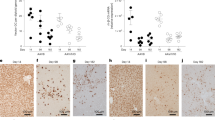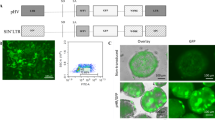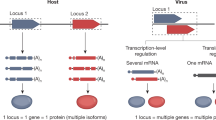Abstract
Introduction of the post-transcriptional regulatory element (PRE) of woodchuck hepatitis virus (WHV) into the 3′ untranslated region of retroviral and lentiviral gene transfer vectors enhances both titer and transgene expression. Optimal use of the PRE is often necessary to obtain vectors with sufficient performance for therapeutic applications. The enhancing activity of the PRE depends on the precise configuration of its sequence and the context of the vector and cell into which it is introduced. However, data obtained in the context of WHV-associated hepatocellular carcinomas suggests that the PRE might potentially contribute to tumorigenesis, especially if encoding a truncated version of the WHV X protein. Oncogenic side effects of lentiviral vectors containing the PRE have reinforced these safety concerns, although a causal role of the PRE remained unproven. Here, we demonstrate that PRE mutants can be generated that are devoid of X protein open reading frames (ORFs) as well as other ORFs exceeding 25 amino acids, without significant loss of RNA enhancement activity. Furthermore, the X protein promoter could be deleted without compromising the enhancement of vector titers and transgene expression. Such a modified PRE sequence appears useful for future vector design.
This is a preview of subscription content, access via your institution
Access options
Subscribe to this journal
Receive 6 print issues and online access
$259.00 per year
only $43.17 per issue
Buy this article
- Purchase on SpringerLink
- Instant access to full article PDF
Prices may be subject to local taxes which are calculated during checkout



Similar content being viewed by others
Accession codes
References
Donello JE, Loeb JE, Hope TJ . Woodchuck hepatitis virus contains a tripartite posttranscriptional regulatory element. J Virol 1998; 72: 5085–5092.
Hope T . Improving the post-transcriptional aspects of lentiviral vectors. Curr Top Microbiol Immunol 2002; 261: 179–189.
Zufferey R, Donello JE, Trono D, Hope TJ . Woodchuck hepatitis virus posttranscriptional regulatory element enhances expression of transgenes delivered by retroviral vectors. J Virol 1999; 73: 2886–2892.
Schambach A, Wodrich H, Hildinger M, Bohne J, Krausslich HG, Baum C . Context dependence of different modules for posttranscriptional enhancement of gene expression from retroviral vectors. Mol Ther 2000; 2: 435–445.
Popa I, Harris ME, Donello JE, Hope TJ . CRM1-dependent function of a cis-acting RNA export element. Mol Cell Biol 2002; 22: 2057–2067.
Fukuda M, Asano S, Nakamura T, Adachi M, Yoshida M, Yanagida M et al. CRM1 is responsible for intracellular transport mediated by the nuclear export signal. Nature 1997; 390: 308–311.
Fornerod M, Ohno M, Yoshida M, Mattaj IW . CRM1 is an export receptor for leucine-rich nuclear export signals. Cell 1997; 90: 1051–1060.
Bogerd HP, Echarri A, Ross TM, Cullen BR . Inhibition of human immunodeficiency virus Rev and human T-cell leukemia virus Rex function, but not Mason-Pfizer monkey virus constitutive transport element activity, by a mutant human nucleoporin targeted to Crm1. J Virol 1998; 72: 8627–8635.
Jacobson A, Peltz SW . Interrelationships of the pathways of mRNA decay and translation in eukaryotic cells. Annu Rev Biochem 1996; 65: 693–739.
Loeb JE, Cordier WS, Harris ME, Weitzman MD, Hope TJ . Enhanced expression of transgenes from adeno-associated virus vectors with the woodchuck hepatitis virus posttranscriptional regulatory element: implications for gene therapy. Hum Gene Ther 1999; 10: 2295–2305.
Mastroyiannopoulos NP, Feldman ML, Uney JB, Mahadevan MS, Phylactou LA . Woodchuck post-transcriptional element induces nuclear export of myotonic dystrophy 3′ untranslated region transcripts. EMBO Rep 2005; 6: 458–463.
Ramezani A, Hawley TS, Hawley RG . Lentiviral vectors for enhanced gene expression in human hematopoietic cells. Mol Ther 2000; 2: 458–469.
Salmon P, Kindler V, Ducrey O, Chapuis B, Zubler RH, Trono D . High-level transgene expression in human hematopoietic progenitors and differentiated blood lineages after transduction with improved lentiviral vectors. Blood 2000; 96: 3392–3398.
Ailles LE, Naldini L . HIV-1-derived lentiviral vectors. Curr Top Microbiol Immunol 2002; 261: 31–52.
Kraunus J, Schaumann DH, Meyer J, Modlich U, Fehse B, Brandenburg G et al. Self-inactivating retroviral vectors with improved RNA processing. Gene Therapy 2004; 11: 1568–1578.
Werner M, Kraunus J, Baum C, Brocker T . B-cell-specific transgene expression using a self-inactivating retroviral vector with human CD19 promoter and viral post-transcriptional regulatory element. Gene Therapy 2004; 11: 992–1000.
Bouchard MJ, Schneider RJ . The enigmatic X gene of hepatitis B virus. J Virol 2004; 78: 12725–12734.
Wei Y, Fourel G, Ponzetto A, Silvestro M, Tiollais P, Buendia MA . Hepadnavirus integration: mechanisms of activation of the N-myc2 retrotransposon in woodchuck liver tumors. J Virol 1992; 66: 5265–5276.
Tang H, Delgermaa L, Huang F, Oishi N, Liu L, He F et al. The transcriptional transactivation function of HBx protein is important for its augmentation role in hepatitis B virus replication. J Virol 2005; 79: 5548–5556.
Sugata F, Chen HS, Kaneko S, Purcell RH, Miller RH . Analysis of the X gene promoter of woodchuck hepatitis virus. Virology 1994; 205: 314–320.
Flajolet M, Tiollais P, Buendia MA, Fourel G . Woodchuck hepatitis virus enhancer I and enhancer II are both involved in N-myc2 activation in woodchuck liver tumors. J Virol 1998; 72: 6175–6180.
Themis M, Waddington SN, Schmidt M, von Kalle C, Wang Y, Al-Allaf F et al. Oncogenesis following delivery of a nonprimate lentiviral gene therapy vector to fetal and neonatal mice. Mol Ther 2005; 12: 763–771.
Kingsman SM, Mitrophanous K, Olsen JC . Potential oncogene activity of the woodchuck hepatitis post-transcriptional regulatory element (WPRE). Gene Therapy 2005; 12: 3–4.
Kondo E, Akatsuka Y, Nawa A, Kuzushima K, Tsujimura K, Tanimoto M et al. Retroviral vector backbone immunogenicity: identification of cytotoxic T-cell epitopes in retroviral vector-packaging sequences. Gene Therapy 2005; 12: 252–258.
Egelhofer M, Brandenburg G, Martinius H, Schult-Dietrich P, Melikyan G, Kunert R et al. Inhibition of human immunodeficiency virus type 1 entry in cells expressing gp41-derived peptides. J Virol 2004; 78: 568–575.
Schambach A, Bohne J, Chandra S, Will E, Margison G, Williams DA, Baum C . Equal potency of gammaretroviral and lentiviral SIN vectors for expression of O6-methylguanine-DNA-methyltransferase in bone marrow cells. Mol Ther 2005, Oct 10; Epub ahead of print.
Dull T, Zufferey R, Kelly M, Mandel RJ, Nguyen M, Trono D et al. A third-generation lentivirus vector with a conditional packaging system. J Virol 1998; 72: 8463–8471.
Baum C, Hegewisch-Becker S, Eckert HG, Stocking C, Ostertag W . Novel retroviral vectors for efficient expression of the multidrug resistance (mdr-1) gene in early hematopoietic cells. J Virol 1995; 69: 7541–7547.
Acknowledgements
We thank R Seyd and M Id for excellent technical assistance. We would like to thank H Schaller, U Protzer and H-G Kräusslich for helpful suggestions. This work was supported by Grants of the European Union (CONSERT, LSHB-CT-2004-005242) and the Deutsche Forschungsgemeinschaft (DFG BA 1837/4).
Author information
Authors and Affiliations
Corresponding author
Rights and permissions
About this article
Cite this article
Schambach, A., Bohne, J., Baum, C. et al. Woodchuck hepatitis virus post-transcriptional regulatory element deleted from X protein and promoter sequences enhances retroviral vector titer and expression. Gene Ther 13, 641–645 (2006). https://doi.org/10.1038/sj.gt.3302698
Received:
Revised:
Accepted:
Published:
Issue Date:
DOI: https://doi.org/10.1038/sj.gt.3302698



